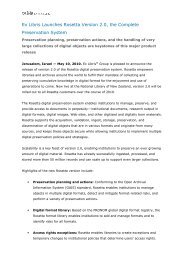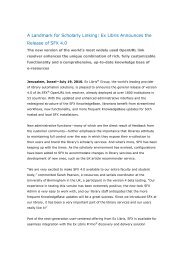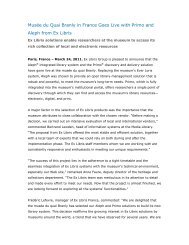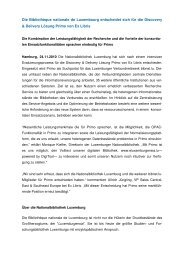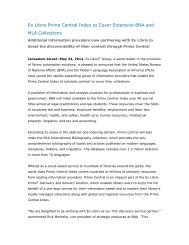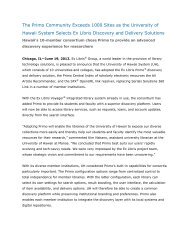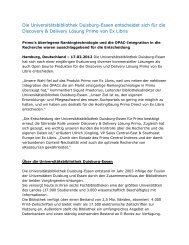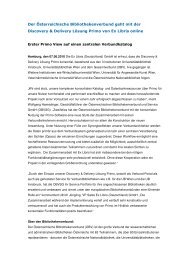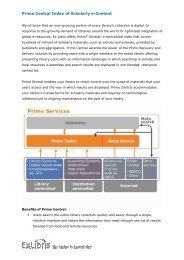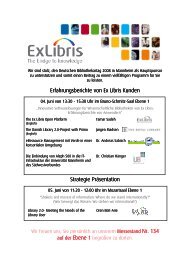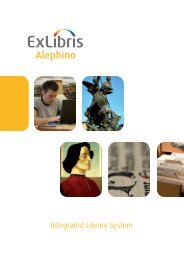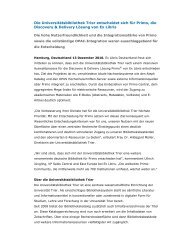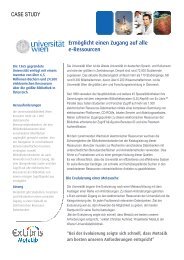October 2005 Issue - Ex Libris
October 2005 Issue - Ex Libris
October 2005 Issue - Ex Libris
You also want an ePaper? Increase the reach of your titles
YUMPU automatically turns print PDFs into web optimized ePapers that Google loves.
Pleased to meet you!<br />
Among the many new and interesting <strong>Ex</strong> <strong>Libris</strong> sites that<br />
have joined us since the last edition of the <strong>Ex</strong> Librian, we<br />
would like to highlight two new DigiTool customers—AITSIS<br />
(Aboriginal and Torres Strait Islander Studies) in Australia,<br />
and the Boston Public Library in the USA:<br />
*AIATSIS is an independent authority devoted to the study<br />
of Aboriginal and Torres Strait Islanders. Its award-winning,<br />
in-house publisher issues an extensive array of books,<br />
cassettes, CDs, films and videos, reports, and the Institute's<br />
journal of Australian Aboriginal Studies. The AIATSIS Library<br />
and Audio/Visual programs hold the world's most extensive<br />
collections of printed, audio, and visual materials on<br />
Aboriginal and Torres Strait Islander topics. These are used<br />
by researchers, museums, galleries, and the general public.<br />
For over 150 years, the Boston Public Library (BPL) has<br />
pioneered public library service in The United States with<br />
revolutionary ideas and famous firsts. Established in 1848,<br />
the BPL was the first publicly supported municipal library in<br />
America, the first public library to lend a book, the first to<br />
have a branch library and the first to have a children’s room.<br />
Today, the BPL boasts 27 neighborhood branches, free<br />
Internet access, two unique restaurants, an award-winning<br />
Website and an online store featuring reproductions of the<br />
BPL’s priceless photographs and artwork. All of its programs<br />
and exhibits are free and open to the public.<br />
While this may not be the traditional season for exchanging<br />
gifts, libraries around the world are taking the wrapping<br />
paper off of their new <strong>Ex</strong> <strong>Libris</strong> products, and (hopefully!)<br />
reading the instruction manuals.<br />
Contributed by Thea Hurwitz, Sales Support Coordinator,<br />
<strong>Ex</strong> <strong>Libris</strong>, thea.hurwitz@exlibrisgroup.com.<br />
- 10 -<br />
The Knowledge Marketplace<br />
As we enter the early 21st century, content creators and<br />
archivists of all kinds are converting analog materials into<br />
new digital forms. At the same time, an explosion of new<br />
digital content is being created every day by students and<br />
faculty around the world in their quest for new knowledge<br />
and forms of creative expression. Today's students are part<br />
of the new digital culture which is creating new opportunities<br />
and roles for libraries to participate in the digital economy.<br />
The community of knowledge creators participating in this<br />
digital shift on campus is expanding to include publishers,<br />
public broadcasting, entertainment, museums, and artists.<br />
The classroom of the future is everywhere, on-demand and<br />
digital.<br />
Our Digital Culture<br />
As more and more content is digitized and important projects<br />
such as Google Print and the Merlot Learning object<br />
repository emerge the issue of where all of this content will<br />
be stored for universal access becomes paramount.<br />
Institutions around the world are investigating and building<br />
new digital repositories in models ranging from personal<br />
digital libraries containing all the materials an individual<br />
cares to capture, create and share to centralized institutional<br />
repositories that offer a new form of collective intelligence<br />
for the academy. Librarians of today have a new opportunity<br />
to apply the skills of the physical world to catalog, index and<br />
make available new taxonomies that enable faculty and<br />
students to quickly locate and share educational materials<br />
created from learning management environments and open<br />
access publishing.<br />
Intellectual Property in the Digital Age<br />
A new era of public policy challenges is emerging in software<br />
and content centered on the principles of digital rights and<br />
copyright in education. Do professors who create original<br />
works own the rights to their materials or does the institution?<br />
What rights must be protected in an era of modular content<br />
in the form of materials that are created that are not intended<br />
to be free? One of the more important directions for the<br />
expression and protection of ideas on the web beyond the<br />
millenium digital copyright act is the Creative Commons<br />
schemas derived from the works of Stanford University's<br />
Lawrence Lessig. These copyright schemas allow for our<br />
digital creators to attach a relatively simple set of 4 rights<br />
models depending on their intended re-use on the web.<br />
These new approaches to content and code are enabling<br />
creative control to thrive in non-commercial models in<br />
parallel to traditional commercially developed ones. In the<br />
end, both models must be allowed to compete, inter-operate<br />
and complement the academic mission of the institution.<br />
Open Systems for Open Minds<br />
As content goes modular and service-oriented architectures<br />
emerge to deliver new forms of communication and<br />
collaboration, critical standards are emerging that allow for



